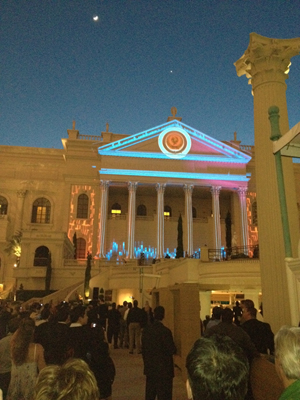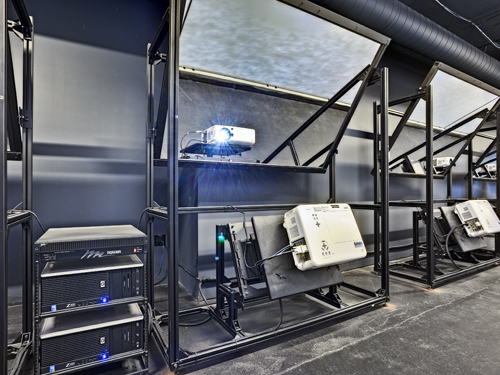Our executive editor has thrown down the gauntlet of reminding readers of the status of projection in the world of digital signage. I will gladly take this challenge– having grown up in the decades of projection long before flat panels were even a glint in the eye of display engineers and scientists. But this article is no exercise in nostalgia. Front and rear projection makes up a small but significant part of the digital signage industry reaching a penetration level exceeding 30% by some estimates. Let the challenge begin.
We recognize the increasing sizes of flat panel displays and this has certainly encroached on the use of projectors in digital signage. Only a few years ago the typical size of a flat panel was 40” and now it is 46” and by the end of this year it is expected to grow to 50” displays as the norm. Of course we also have the 65”, 70” 80” and even 103” and 152” flat panels. One side of the argument says that flat panels are making projection obsolete. Flat panels are easier to install and are more resistant to ambient light degradation of the image and they do not require a separate screen. In addition installation costs are less for flat panels and with lamp replacements for projectors, the total cost of ownership is simply too high. All this being said, there are always two sides to consider so let’s take a look at the pro-projector group with the caveat that if a flat panel is perfect in terms of environment, size, shape, light output, etc. it will be used. It rarely if ever makes sense to use a projector for a 55” to 65” images unless an unusual size or shape is needed. Above those minimum sizes, there may be pluses and minuses for either choice.
Portable Power
A critical element to keep in mind with projection is to think outside of the box; literally outside of the projector itself and look at ways to incorporate projection where flat panels are not appropriate. Also keep in mind as you get creative in your thinking that there are three elements to consider in projection. They are ambient light, the projection screen or surface, and the projector itself. With the caveats aside we are now ready to explore new technologies.

At the trade show CinemaCon in April 2012, event producers DWP Live and Monster Media 3D, teamed up to produce a gigantic 3D projection mapping show enveloping the exterior wall of Caesars Palace above the shining Neptune Pool, for a corporate event hosted by projector manufacturer Barco. Three stacks of four Barco’s HDX-W18 large venue projectors created a huge panoramic image covering a 96’ x 125’ area featuring a single 3,072 x 2,160 pixel edge-blended video show. The event marked the first time that the iconic Caesars Palace hotel and casino in Las Vegas, Nevada, was pixel mapped
(Click here to watch a YouTube video of the event.)
I am sure you have all seen the tiny little Pico projectors that look like toys the size of a cell phone rather than serious projectors but I urge you to stop and take another look. A couple of years ago the brightest Pico projector was about 10 lumens rendering it useless for true digital signage applications. Fast forward to current products in the category and they now produce up to 50 lumens of light output. Just remember in the good old days our beloved CRT projectors only produced twice that amount of light on big screens. Imagine taking a Pico projector and using it inside display cases or for unique applications like the folks at DLP showed last year with a Pico projector tree with the images projected onto the leaves. You can tuck these little projectors into nooks and crannies and let the creative juices flow.
Next up on the food chain are the pocket projectors. These dandy little devices will fit in the palm of a big hand and are about the size of a couple of paperback books stacked together. Light output is the key here. They now produce from 100 to 500 lumens of light output and they use LED illumination sources that eliminate the need to replace lamps every 2k to 3k hours. The other thing to keep in mind is that most use a sealed optical system and you can use them in less than perfectly clean environments. With 300 to 500 lumens of light output this means you can produce images on a par with flat panel displays in terms of brightness and they can be installed in some applications where flat panels cannot.
Before continuing up the evolutionary ladder it is important to interject that as flat panel sizes get above the 46” to 55” range, price becomes a consideration. When considering where to use a flat panel or a pocket projector, there is not a huge price differential in the systems hardware but from 60” and above, projection may be a more affordable approach and in some cases preferable if the environment is appropriate.

Digital Signage in the entrance lobby of 505 1st Avenue South, a new office building in downtown Seattle. The 9ft high by 52 ft wide rear-projection wall has its content managed and delivered by six DLP projectors from NEC, each with its own PC workstation running Dataton WATCHOUT to offer seamless edge-blending, overlapping, and meshing of images, all in complete synchronization. A seventh PC is used as a master production computer, running its own copy of WATCHOUT. Local Seattle creative agency, Mind Opera created all the content. (Photo by Gary Wilson.)
The most significant news in projection for digital signage comes in area of portable projectors. This is a misnomer of sorts because these projectors are portable but can also be permanently installed as well. The brilliance (pun intended) in the new products is in the illumination sources. As most know, traditional projection uses a lamp to illuminate the screen and of course these lamps ultimately burn out. This translates into increased TCO, continuous maintenance and an image that decays as the lamp ages. We will use Casio as an example of a new approach to projection illumination. Their laser hybrid design uses a laser, LED, and phosphors to provide illumination. They have units capable of 2500 to 4000 lumens of light output and the images remain consistent with no visible decay. Other companies are joining in as well. Optoma, DPI, and a far-east company called CRE all have projectors with LED or hybrid illumination. Stay tuned for more on the horizon.
The Men Behind the Curtain
Rear Projection for Digital Signage
BY RANDY PAGNAN, RP VISUAL SOLUTIONS

- RP Visuals was founded in 2005, and originally the RP was supposed to stand for Rear Projection. Now over 60% of our business is derived from mounting flat panels in strange and unique ways. Yet, true to our origins, our Rear Projection business remains strong and continues to grow. This growth is primarily coming from unique rear projection installations for digital signage.
This is just a sampling of rear projection (RP) projects we’ve recently done:
• Non-standard Aspect Ratio. Recently we were approached by Cavtocci /Whitlock for a project at NEU. This job is quite cool and involved Stewart, Projection Design, Vista, Scalable, PQ Labs and RP Visual Solutions. This Visitor’s Center enables a glass foyer to come alive with video images powered by Downstream– in a unique blended rear screen application that is touch enabled. There are 3 areas– each different and unique– and truly this application could not be better served by any other technology but RP – REAR PROJECTION. This Visitor’s center will allow NEU to “sell” their university in a truly collaborative and technology future method.
• TWIST and WARP. Gone are the days of filling a rear screen with a standard 4:3 or 16:9 (or 10) image. Today hitting a screen anything but square (optically on-axis) typically resulting in a trapezoidal image, and that results in the need for content creators to generate very clever images to compensate for this geometrically deformed image. This McCann Systems job was done for selling suites of the Brooklyn arena.
• SEAMLESS – DUAL SIDE Viewed – Rear Projection. HB Communications had a clever idea to build a digital fireplace at the MUSE hotel in New York – where you can view the image from both sides. And the fire won’t burn you.
• NON-STANDARD Aspect Ratio. Rear Projection allows you to project a concave or convex image, a serpentine image, a circle / square – or just about anything your digital content folks can envision. Yes, you need RP space but the racks have to go somewhere- and where else are you going
to store old AV junk?
• TRULY CUSTOM SIZES. If your digital signage need requires a 96 ½ inch image diagonal image, exactly, we can do that (as opposed to say, shadow masking a Panasonic 103 flat panel).
• POLORIZING LCD (aka SNAP Glass) allows for a translucent (clear) piece of glass to suddenly become a rear projection image.
• CINECLEAR (aka HOLO) screens allow for an image to be projected in front of merchandise – such that you can see the merchandise and a ghostly image.
Yes, Rear Projection will carry on – no matter how large and cheap panels become, but the business is different and becoming increasingly unique and challenging– which we like.
Now we have enough illumination power to rival some of the larger flat panel displays especially if one of the new ambient light rejection, high gain screens is used. These screens come in models from 2 up to 5 gain and are what we call engineered screens. In other words they are engineered for a specific purpose and not simply a surface on which to project random images as in a boardroom or class room where ambient light can easily be controlled. Recently at the Digital Signage Expo, Capture Screens showed off their newest screens in relatively high ambient light conditions and they looked very good. Pro Displays is another company with high gain screens and most folks are familiar with Da-Lite, Draper, DNP and their products. The bottom line is that a bright projector and a properly engineered high gain screen can be an excellent choice and in most cases less expensive than 80” to 152” flat panel displays.
The Big Guns
At the top of the heap relative to projection, we have the big guys. Companies like Christie Digital, Barco, NEC, and Digital Projection International (DPI) specialize in really high brightness displays from 8K up to the 35K to 40K range and you will soon see cinema projectors using lasers that are even brighter than that. Now we are talking about horsepower. These massive projectors can produce images up to the size of full buildings. They include blending technologies and warping engines that permit images to be manipulated in ways not possible 5 years ago. They can even make a 2D image look like 3D on the side of a building or huge surface area whether it is flat or not. Use your favorite search engine on your PC or Mac and see what these technologies can produce. Now this is not the low priced spread but no flat panel can do what these behemoths can do so budget permitting it is worth considering.
Techorating
Hopefully you have an idea that projection can be the technology of choice in certain applications and in some cases can do things that flat panels cannot. It is time to wrap up our little journey with some really cool projection based products that may generate a little of that out of box thinking we spoke about before.
One of the most creative products out there is MicroTiles from Christie Digital. Just think about these as small rear projection Lego style building blocks and play designer to your heart’s content. You have unlimited design options and they even come with a neat design software package that lets you configure what you want in a design mode before deployment. They are durable, bright, have tiny mullions, and scale in resolution as you tile the displays. They can even be used as touch screens.
One of our favorite applications for Micro Tiles and other projection technologies as well falls under what we call Techorating. This is the use of display technologies as part of the décor and interior design. Techorating may include the use of unusual shapes and downward facing images projected on the floor for artistic effect, or wall washes with video, etc. These are things that projectors can do that flat panels cannot.
Another one of my favorites is the ever-expanding number of short throw protectors out there. From a digital signage perspective they can be mounted in a soffit very close to the wall and large images can be projected and even blended side by side to do a long video wall with no mullions. Some manufacturers even provide touch screen software to allow the use of interactivity in the design.
I have left the best projector story for the last. I was walking down the aisle at a trade show and to my left was a very pretty young lady selling her company’s product. So what you say? I looked at her again and she was life size but projected on a screen cut out to look just like her body shape. Projected on this screen was this young woman. I will say no more. Go to You Tube and look up Casio Virtual Presenter.
For those who say projection is passé or that it cannot compete with flat panel displays and video walls, think again. In our industry it is creative thinking and designing digital signage systems that create impressions and insure recollection. If you simply see a display that action creates what we call an impression. If you remember what is on the display that is recall and this is what every digital signage network is striving for. Creativity and great content are the keys to the kingdom so enjoy the trip outside of your own personal box.Alan Brawn (alan@BrawnConsulting.com) is a principal of Brawn Consulting LLC an audio visual and IT consulting, educational development, and market intelligence firm with national exposure to major manufacturers, distributors, and integrators in the industry. He was formerly President of Telanetix and previously National Business Development and Product Marketing Director, Samsung Electronics. Brawn is a member of the Imaging Science Foundation and Managing Director of ISF Commercial. Alan is CTS certified and an adjunct faculty member of InfoComm, and chairs its ISO/ANSI Projected Images Task Group. He is a member of the International Commission on Display Metrology for SID and a Learning Unit provider for NSCA and instructor at CEDIA. Most recently he became Director of the Digital Signage Experts Group certifying professionals in the digital signage industry. (Visit www.digitalsignageexperts.org for information about the Digital Signage Certified Experts program)
